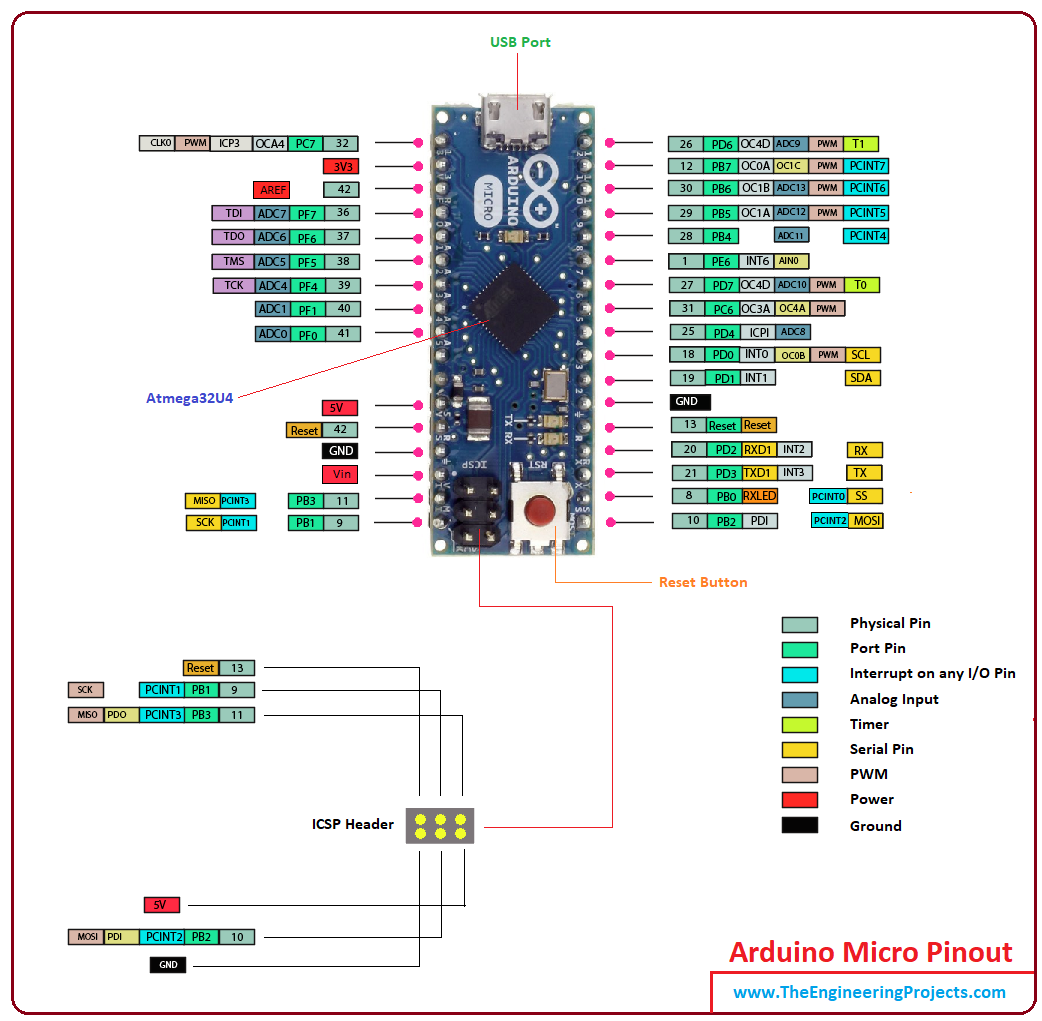
Introduction to Arduino Micro
- Arduino Micro is the smallest board in the Arduino Community and is mainly based on the ATmega32U4 microcontroller.
- It contains a built-in USB on the tiny easy to integrate interface, that helps in laying out a prompt connection with the computer.
- Don't get into the illusion of performing complex functions that require more memory space, as this little toy comes with flash memory around 32 KB while EEPROM and SRAM are 2.5 KB and 1 KB respectively, still enough to wet your technical appetite.
- The maximum length and width of the Micro PCB are 4.8cm and 1.77cm respectively, however, with the attached USB port the dimensions will slightly be larger than the given parameters, exceeding from the edge of the PCB layout.
- Breadboard compatibility makes this device easy to use for getting a hands-on experience before incorporating it in the relevant project with all prerequisites.
- You can download Arduino Micro Datasheet by clicking below button:
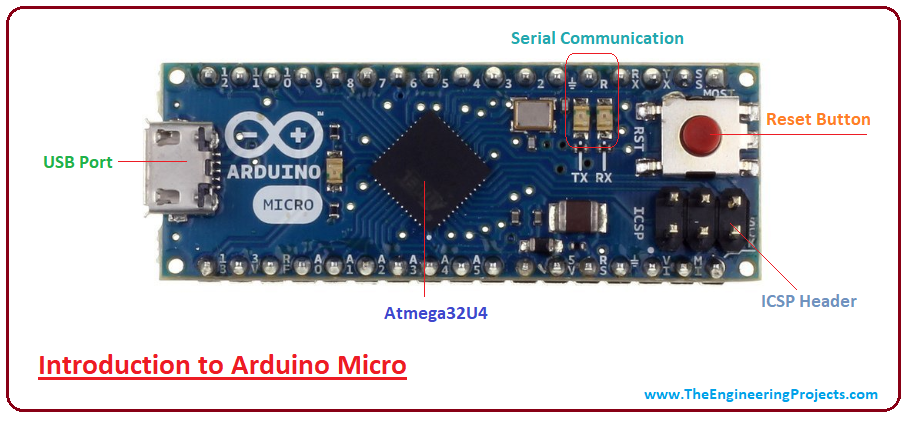
- The ATmega32U4 microcontroller available on the board features UART communication with TX and RX pins.
- The Micro board incorporates resettable poly-fuse that that is mainly used for securing computer's USB ports from shorts and overcurrent by providing an extra layer of protection.
- If the current escalates from the required value to the USB port, the fuse will jump in and work as an emergency switch, breaking the connection between the board and computer. It is advised to keep the provided current to the USB port under 500mA.
1. Arduino Micro Features
If you are aiming to pick this Arduino module for your relevant project, it is advised to get a hold of its features in order to avoid any hassle in future. The following figure shows the main features of Arduino Micro.| Microcontroller | ATmega32U4 |
| CPU | 8-Bit |
| Digital I/O Pins | 24 |
| PWM Output | 7 |
| Analog Input | 12 |
| Flash Memory (Program Memory) | 32 KB |
| SRAM | 2.5 KB |
| EEPROM | 1 KB |
| Input Voltage | 7-12 V |
| Operating Voltage | 5 V |
| Oscillator | up to 16 MHz |
| Software Used | Arduino Software (IDE) |
| Reset Button | Yes |
| ICSP Header | Yes |
| USB Port | 1 |
| UART (Serial Communication) | Yes |
- Serial communication along with SPI and I2C communications are available on the board. The physical reset button is added that helps to stop the running function and puts the controller in the initial condition from where it takes and implements the stored information from scratch.
2. Arduino Micro Pinout
Following figure shows the Arduino Micro Pinout diagram.
- You may have heard, at times, tiny things work wonders. Same is true with this module. It is nothing but a technical peripheral device with a number of features laid out and housed in one package.
- Still, as I have mentioned earlier, it operates perfectly if you plan to design the simple project that requires less memory space. Arduino Due and Arduino Leonardo are preferred to meet your technical needs if your project requirements are complex and require more memory space in order to design and drive automation in the relevant project.
- The built-in USB communication on the board removes the need for a secondary processor and helps it to appear to a connected computer as a keyboard and mouse, in addition to a virtual (CDC) serial / COM port.
3. Arduino Micro Pin Description
Until now, you have got a brief overview of this device and how this module can be a good fit for your project. In this section, I'll discuss the pin description with images, you can easily grab the idea what are the major functions associated with each pin. Let's get to the point.Analog Input
There are 12 analog inputs on the board. You can see them in the figure below.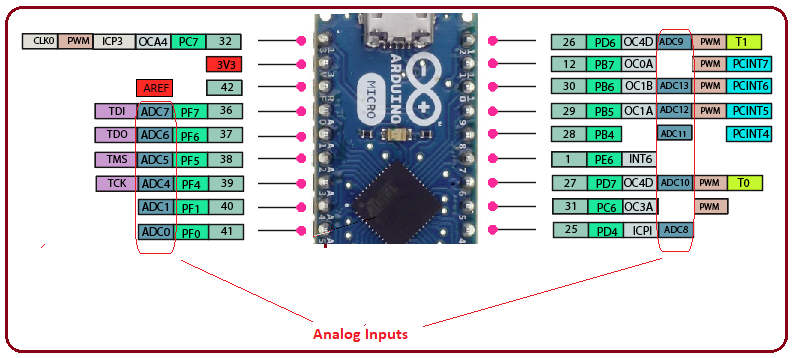
Communication Protocols
Communication protocols like serial, SPI and I2C are incorporated on the board. You can see them highlighted on the figure below.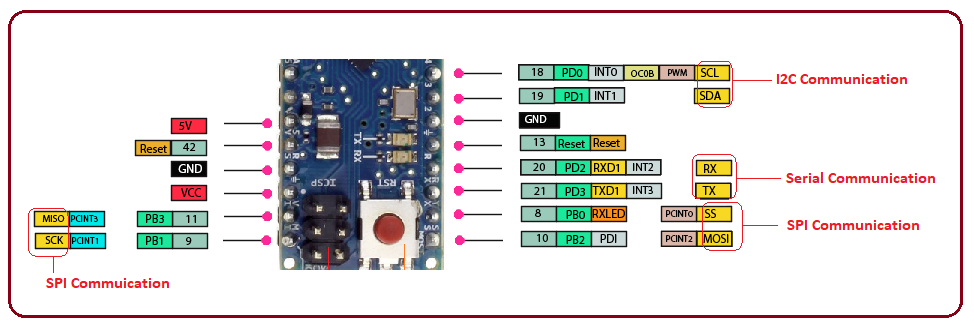
PWM Output
Seven pins are used for PWM output purpose. It is a process for getting analog results with digital means. You can see PWM in the figure below.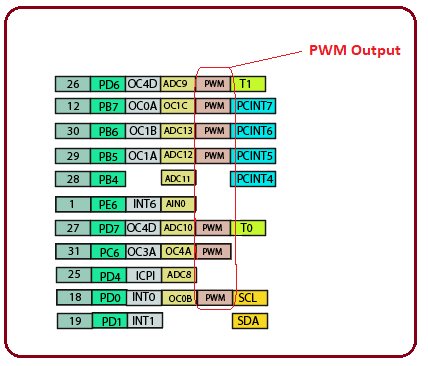
Power Source
The 5V is a voltage at which board operates while 3.3V is the operating voltage of each pin. The Vin is the input voltage that ranges between +7 to +12 V and is a voltage from the external power source, not from a USB port. There are two ground pins on the board. The AREF predicts the Analogue reference voltage that helps to inject the Arduino a reference voltage from an external power supply. You can see the power source in the figure below.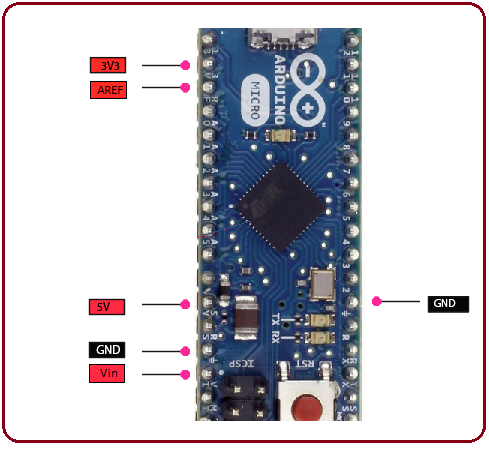
External Interrupt
PCINT are the external interrupts generated on any digital I/O pin. The following figure shows the pins on which external interpret can be generated.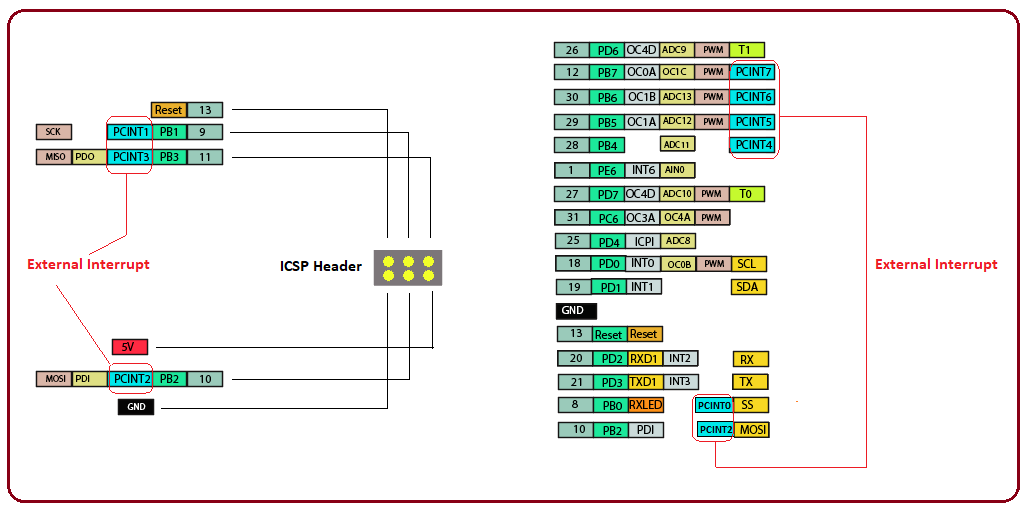
ICSP Header Pins
ICPS head is added on the board and it stands for In-Circuit Serial Programming - A feature used for programming Arduino with another Arduino. And if USB port is not available, it comes out handy for connecting the board with a computer for uploading a sketch.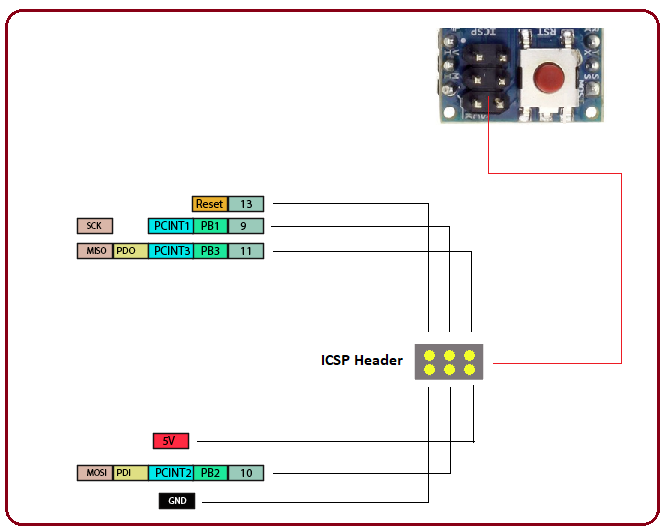
4. Programming
- Arduino Software, called IDE, is mainly used for programming the Arduino module and it works perfectly with common operating systems like Windows, Linux or MAC. You can download it from the Arduino site and it is compatible with all versions in the Arduino family.
- You are ready to use the software as you install it. Some simple LED programs are already available on the software so you can easily start working on the board and compile the default program with the intention you are getting the results on the fly.
- Built-in bootloader that comes with the board lets you off the hook from wresting your mind for compiling and burning the code using the external burner.
- Micro board features a serial peripheral interface (SPI) that is mainly used in the communication between the microcontroller and other peripheral devices such as shift registers and sensors. Two pins are used for SPI communication i.e. MOSI (Master Output Slave Input) and MISO (Master Input Slave Output) - they are used for sending and receiving the data by the microcontroller.
- The Serial Monitor is added in Arduino Software, that plays a vital role in transmitting textual data to or from the board.
- The TX and RX pins are used for serial communication where TX pin transmits the serial data while RX receives the serial data.
- The board is capable to perform I2C communication using two pins called SDA and SCL.
5. Difference between Arduino ProMini and Arduino Micro
- There is a little difference between Arduino ProMini and Micro board, however, peripherals on these boards are same. The built-in USB in the Micro board proves to be a candid difference between two modules while Promini requires FTDI cable in order to generate USB power and communication to the board.
- The USB on Micro board can act as a number of ways: Keyboard or mouse, USB hard drive, USB to serial Converter and MIDI controller.
- The Arduino Pro Mini incorporates ATmega328 microcontroller while Arduino Micro comes with ATmega32U4. Flash memory is the same on both modules however, SRAM differs slightly with 2KB on the ProMini and 2.5 KB on the Micro board.
- Last not least, the Arduino Pro Mini features 2 hardware interrupts while the Micro board comes with 5 hardware interrupts.
6. Arduino Micro Projects and Applications
Arduino micro comes with a wide range of applications with the ability to groove in hard to reach places. It offers a high number of connections with a minimum interface. The outstanding ability of this board to disguise keyboard or mouse while connected with a computer makes it an ideal choice for many computer applications. You can use this board for the development of the following projects.- USB Joystick
- Electric Bike
- Windows PC lock/unlock application
- Creating wireless keyboard
- Automatic Pill Dispenser
- USB Trackpad
- Water Level Meter



